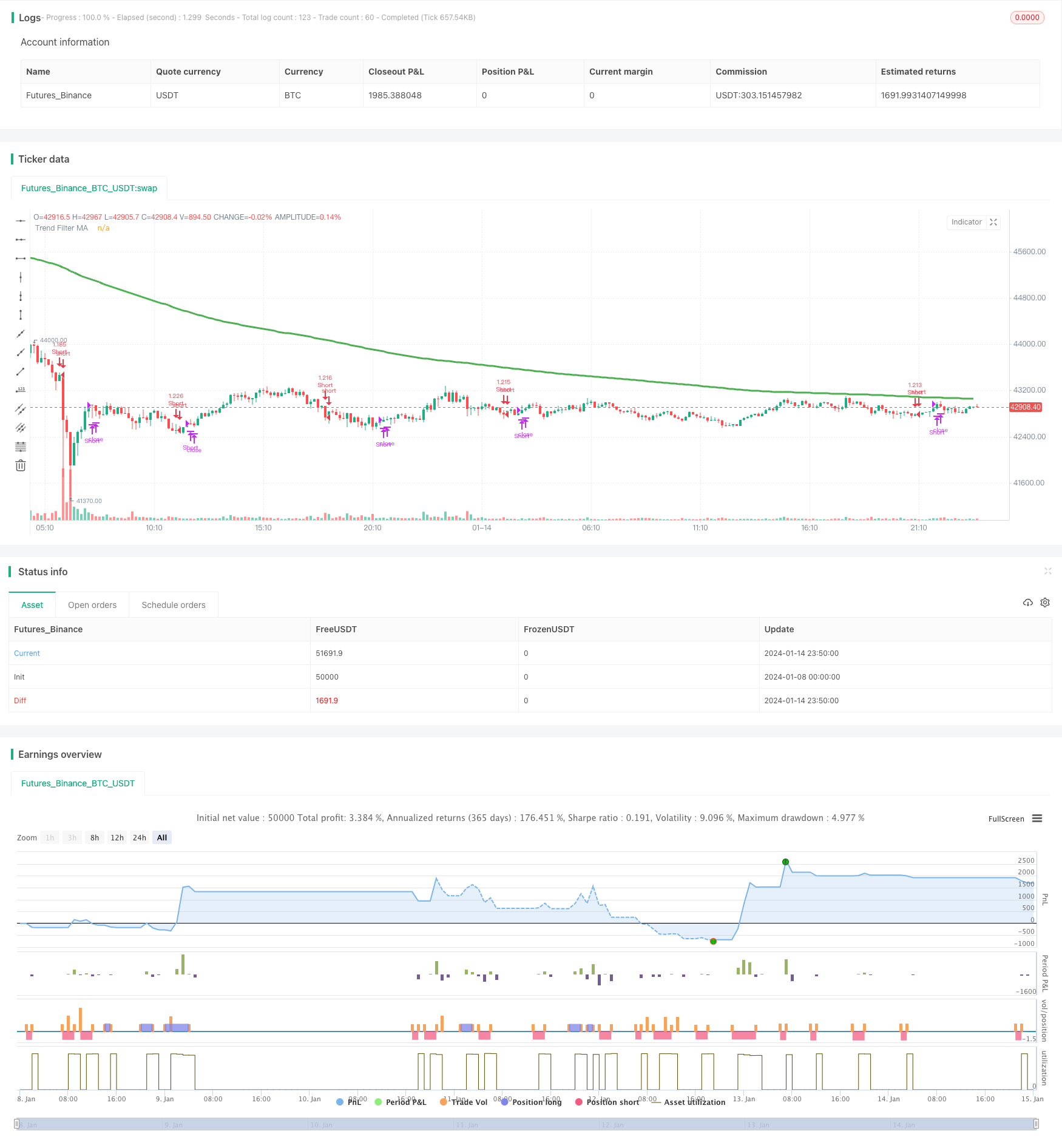
概述
该策略基于ADX指标判断市场趋势,结合DMI指标判断多空方向,利用ADX斜率判断趋势力度,设定ADX关键值过滤非趋势市场,辅助移动平均线过滤交易信号。
策略原理
- 计算ADX、DI+、DI-指标。
- ADX斜率>0,表明趋势递增;关键值设定为23,用于过滤非趋势市场。
- DI+高于DI-,表明多头力量大于空头力量,为看多信号。
- 启用移动平均线过滤时,只有收盘价高于移动平均线时,才产生多头信号。
- 当ADX斜率时平仓,表明趋势消退。
优势分析
- 辅助MA过滤,可减少非趋势市场的噪声交易。
- ADX斜率判断力度,可准确判断趋势的发展。
- DI判断方向配合ADX判断力度,形成比较完整的趋势交易决策体系。
- 回撤和盈亏比有望优于简单的移动平均线策略。
风险分析
- ADX指标设定不同参数,结果会有较大差异。
- DMI尚未完全确定多空方向前,可能发出错误信号。
- 存在一定的滞后,降低策略效率。
优化方向
- 优化ADX参数组合,寻找最佳参数。
- 增加止损策略,避免单笔亏损扩大。
- 尝试结合其他指标过滤信号。例如RSI、布林带。
总结
该策略充分利用ADX判断趋势和趋势力度的优势,配合DMI指标判断方向,形成完整的趋势跟踪体系。同时辅助移动平均线可有效过滤非趋势市场的噪声。参数优化和指标组合还可进一步提高策略稳定性和效率。总体而言,该策略结合趋势判断和方向判断的特点,可望获得良好的回报。
策略源码
/*backtest
start: 2024-01-08 00:00:00
end: 2024-01-15 00:00:00
period: 10m
basePeriod: 1m
exchanges: [{"eid":"Futures_Binance","currency":"BTC_USDT"}]
*/
//@version=4
// This source code is subject to the terms of the Mozilla Public License 2.0 at https://mozilla.org/MPL/2.0/
// © millerrh with inspiration from @9e52f12edd034d28bdd5544e7ff92e
//The intent behind this study is to look at ADX when it has an increasing slope and is above a user-defined key level (23 default).
//This is to identify when it is trending.
//It then looks at the DMI levels. If D+ is above D- and the ADX is sloping upwards and above the key level, it triggers a buy condition. Opposite for short.
//Can use a user-defined moving average to filter long/short if desried.
// NOTE: THIS IS MEANT TO BE USED IN CONJUNCTION WITH MY "ATX TRIGGER" INDICATOR FOR VISUALIZATION. MAKE SURE SETTINGS ARE THE SAME FOR BOTH.
strategy("ADX | DMI Trend", overlay=true, initial_capital=10000, currency='USD',
default_qty_type=strategy.percent_of_equity, default_qty_value=100, commission_type=strategy.commission.percent, commission_value=0.04)
// === BACKTEST RANGE ===
From_Year = input(defval = 2019, title = "From Year")
From_Month = input(defval = 1, title = "From Month", minval = 1, maxval = 12)
From_Day = input(defval = 1, title = "From Day", minval = 1, maxval = 31)
To_Year = input(defval = 9999, title = "To Year")
To_Month = input(defval = 1, title = "To Month", minval = 1, maxval = 12)
To_Day = input(defval = 1, title = "To Day", minval = 1, maxval = 31)
Start = timestamp(From_Year, From_Month, From_Day, 00, 00) // backtest start window
Finish = timestamp(To_Year, To_Month, To_Day, 23, 59) // backtest finish window
// == INPUTS ==
// ADX Info
adxlen = input(14, title="ADX Smoothing")
dilen = input(14, title="DI Period")
keyLevel = input(23, title="Keylevel for ADX")
adxLookback = input(3, title="Lookback Period for Slope")
// == FILTERING ==
// Inputs
useMaFilter = input(title = "Use MA for Filtering?", type = input.bool, defval = true)
maType = input(defval="EMA", options=["EMA", "SMA"], title = "MA Type For Filtering")
maLength = input(defval = 200, title = "MA Period for Filtering", minval = 1)
// Declare function to be able to swap out EMA/SMA
ma(maType, src, length) =>
maType == "EMA" ? ema(src, length) : sma(src, length) //Ternary Operator (if maType equals EMA, then do ema calc, else do sma calc)
maFilter = ma(maType, close, maLength)
plot(maFilter, title = "Trend Filter MA", color = color.green, linewidth = 3, style = plot.style_line, transp = 50)
// Check to see if the useMaFilter check box is checked, this then inputs this conditional "maFilterCheck" variable into the strategy entry
maFilterCheck = if useMaFilter == true
maFilter
else
close
// == USE BUILT-IN DMI FUNCTION TO DETERMINE ADX AND BULL/BEAR STRENGTH
[diplus, diminus, adx] = dmi(dilen, adxlen)
buySignal = (adx[0]-adx[adxLookback] > 0) and adx > keyLevel and diplus > diminus and close >= maFilterCheck
// buySignalValue = valuewhen(buySignal, close, 0)
shortSignal = (adx[0]-adx[adxLookback] > 0) and adx > keyLevel and diplus < diminus and close <= maFilterCheck
// shortSignalValue = valuewhen(shortSignal, close, 0)
sellCoverSignal = adx[0]-adx[adxLookback] < 0
// == ENTRY & EXIT CRITERIA
// Triggers to be TRUE for it to fire of the BUY Signal : (opposite for the SELL signal).
// (1): Price is over the 200 EMA line. (EMA level configurable by the user)
// (2): "D+" is OVER the "D-" line
// (3): RSI 7 is under 30 (for SELL, RSI 7 is over 70)
// 1* = The ultimate is to have a combination line of 3 EMA values, EMA 14, EMA 50 and EMA 200 - And if price is over this "combo" line, then it's a strong signal
// == STRATEGY ENTRIES/EXITS ==
strategy.entry("Long", strategy.long, when = buySignal)
strategy.close("Long", when = sellCoverSignal)
strategy.entry("Short", strategy.short, when = shortSignal)
strategy.close("Short", when = sellCoverSignal)
// == ALERTS ==
// alertcondition(buySignal, title='ADX Trigger Buy', message='ADX Trigger Buy')
// alertcondition(sellSignal, title='ADX Trigger Sell', message='ADX Trigger Sell')